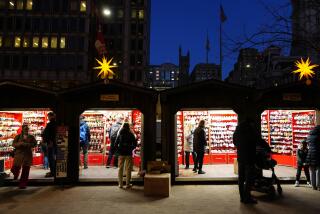Black Friday highlights the contrast between rich and poor

In Northeast Los Angeles, 1,000 people huddled in the evening chill last Thanksgiving as they waited outside a Target store for the chance to snap up Black Friday deals.
Across town at the Grove, the mostly upscale stores such as Barneys and Nordstrom were closed that night. Holiday shoppers didn’t start massing until well into the next morning.
This year’s annual ritual of conspicuous consumption promises an even greater contrast.
Discounters and mid-priced chains, eager to gain an edge on competitors for limited gift budgets, have again moved their opening times earlier into Turkey Day, with Kmart leading the pack by launching specials at 6 a.m. Higher-end retailers, however, are keeping their doors firmly shut until Friday.
Increasingly, the seasonal shopping surge has become a window into America’s class divide, in which high earners have benefited from a booming stock market and rising home prices as many others still grapple with stagnant incomes and lingering financial anxiety.
Consider these opposite scenarios: In 2013, Bloomingdale’s went against the grain by offering fewer Black Friday bargains than the year before, according to the advertising experts at bestblackfriday.com. At a Wal-Mart in Duarte, customers elbowed one another to get their hands on Crayola crayon sets, marked down to $11 from nearly $20. (A trending Twitter hashtag last Thanksgiving was #WalmartFights.)
“You have people who really need a bargain — they will sit out for two days to get that deal because that may be the only big thing they can afford for the whole family,” said Britt Beemer, founder of America’s Research Group. “Luxury retailers don’t do very well on Black Friday because their customers are not going to fight the crowds.”
Uncertainty is driving both retailers and customers, especially on the lower end.
The National Retail Federation has forecast that spending will climb 4.1% to $617 billion in November and December, compared with a 3.1% increase the same period last year.
But a separate survey by PricewaterhouseCoopers predicted average household spending for the holidays will fall to $684 from $735 last year.
The slump is driven by those who earn less than $50,000, called “survivalists,” whose ranks have been growing. This year, 67% of American shoppers fall into that category, up from 63% two years ago, the report said.
These are the families that retailers will fight over Thanksgiving night — ones with limited budgets who are willing to gobble down their apple pie and hustle to the malls to score enough discounts to check off Christmas lists, said Ken Perkins, president of Retail Metrics Inc.
“Once they have spent their budgets, they are done,” Perkins said. “Retailers know if they get them first, they may not have anything left to go to other stores.”
Dwandalyn Johnson, 51, said waiting in line on Thanksgiving night is worth the hassle.
Johnson, a pastor and retired insurance clerk, said she is financially stable but still needs to keep an eye out for bargains. In previous years, the Moreno Valley resident has fanned out with her entire family to local malls, snapping up Coach purses and other expensive products for far less than retail price. They’re planning to do the same this year.
“If Black Friday wasn’t here, we’d go into debt from Christmas shopping,” she said. “I can buy things I wouldn’t otherwise buy, and you can buy two or three outfits instead of one.”
Discount and mid-level retailers, which struggled last holiday season, are working extra hard to bring on the cheer.
Wal-Mart Stores Inc., which suffered nearly two years of flat or falling U.S. same-store sales before posting a gain in the third quarter, rolled out its layaway program in September and has promised to match the prices of rival online retailers. J.C. Penney will open its doors at 5 p.m. Thursday, three hours earlier than last year.
“We are seeing our customers save money, cut back where they can so they can come in and shop,” Wal-Mart spokeswoman Deisha Barnett said.
Lower-end retailers have been crunched at two sides. Financially strapped consumers are still struggling. High earners who patronized them when times were tough have left to go shop at pricier department stores, analysts said.
“That 1% came down to the Wal-Marts and Targets to spend their dollars,” said Ron Friedman, a retail expert at consulting and accounting firm Marcum. “Now that the economy is improving they are going back to Nordstrom.”
That’s given a boost to luxury retailers. Nordstrom recently said third-quarter sales surged 8.9%. LVMH, the owner of Louis Vuitton and Dom Perignon champagne, reported overall sales climbed 5.2%.
Designer mecca Neiman Marcus normally greets customers at 10 a.m. weekdays but is opening its doors a little sooner on Black Friday — at the relatively civilized hour of 8 a.m. For a retailer that already has sold nearly four dozen Maserati sports sedans priced at $95,000 apiece from its fantasy holiday gift catalog, the earlier opening is more an acknowledgment of the big shopping weekend than an attempt to lure customers.
“We typically sell things people want, not necessarily what they need,” spokeswoman Ginger Reeder said. “Thanksgiving promotions are about necessities that are marked down. It’s just not a part of what we do.”
Many with the budget for the finer things in life wouldn’t go out on Thanksgiving — or early Friday morning — even if their favorite boutiques were open.
Browsing at a Louis Vuitton store one recent Saturday, Elena Jorniak, 47, said she’s never lined up for Black Friday. Jorniak, who is chief executive of a hospice care company, said she has no desire to cut dinner short or face the crowds televised on the news every Thanksgiving.
“I heard it was crazy, people pushing each other,” the Glendale resident said. “I can wait. I’m financially secure.”
Twitter: @ByShanLi







